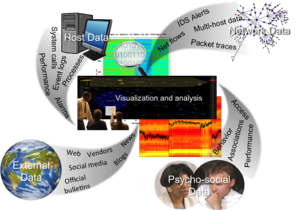We’ve often talked about how analytics can benefit business decision making, but we’ve not said a lot about how having access to data and analytics might affect decision making in our personal lives. Our on-board data collection and processing systems — body and brain — are notoriously unreliable and replete with kludgy heuristics that might have helped us escape from sabre-tooth tigers on the grasslands of our evolutionary history, but aren’t particularly adept at helping us to negotiate the complexity of information-drenched modernity. The so-called quantified life — making use of the sensors in mobile devices and networked services that share data to plot the moment of our existence — affords a more precise means of appraising our past behavior and altering our future decisions.
Stephen Wolfram is a pioneer of the quantified life. The creator of Mathematica and Wolfram Alpha has been recording his digital traces for decades. He does it as an exercise in self-awareness, an attempt to be able to look back and plot the pattern of his days, supplementing his inevitably foreshortened natural memories. It’s fascinating to look at his plotted email activity and see how it reflects his changing behavior, circumstances, and character over many years.
Wolfram has made a deliberate effort to record his data, but with the rise of social media, hundreds of millions of people have been doing the same thing as a side effect of their digital lives. Twitter and Facebook streams capture more information about us than the journals and diaries of yesteryear ever did. In fact, Wolfram Alpha, the computational knowledge engine, has a tool that allows Facebook users to apply numerous analytics to their own data streams.
However, personal data analytics is not just of historical (or narcissistic) interest; it can help provide the necessary information for making future decisions. A large number of consumer devices and services have arisen in recent years that give people the ability to collect, monitor, analyse and predict their behavior. One of the most prominent examples is the Fitbit, a wireless activity tracker that packs a variety of sensors into a small device that can record exercise levels and sleep patterns so that fitness fans can adjust their behavior for maximum effectiveness. TicTrac is a service that promises to reveal how their users tick, recording a plethora of data for later consideration. One of the most notable aspects of the quantified life is how surprised many people seem to be when they see the analytics. Often the data reflects neither their intentions nor their recollections, and so provides a powerful resource for tracking and adjusting behavior to match goals.
Personal data collection, and the services it makes possible, is among the most exciting areas of consumer technology development. Google has already brought us Google Now, the nascent personal assistant the presents the information that it thinks we need, when we need it, without our interaction. Apple’s Siri — which uses Wolfram Alpha — is one of the dominant contenders in this space. With the coming of Google Glasses, should they meet the hype, personal data collection will reach new levels, and the ways we interface with that data to enrich our sensory experience could inaugurate extensive changes to the way we behave. Steve Mann and his EyeTap program has already walked some way down this path.
As always where data is concerned, there are significant privacy and security concerns, but the coming of the quantified life, coupled with mobile computing, advances in analytics, data storage infrastructure, and data center technology, will have a significant impact of many aspects of our lives.



